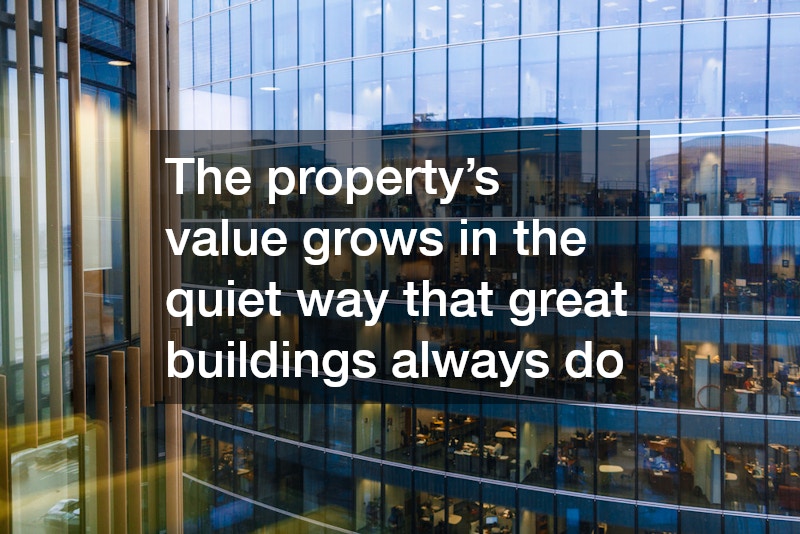
Keeping a multi-floor commercial property clean, safe, and profitable is about predictable routines backed by smart upgrades. The buildings that age well rely on a documented plan, disciplined vendor oversight, and a clear picture of how people and equipment move from the lobby to the highest floor. When those fundamentals are in place, daily operations feel calmer, tenants stay longer, and emergency calls become rare.
Think of the property as a system with interlocking parts. Entrances shape indoor cleanliness, vertical transport defines accessibility, and mechanical rooms determine comfort more than any single lobby refresh ever could. The following strategies focus on durable processes that reduce risk, improve visitor experience, and keep common areas looking like they were opened yesterday—no matter how many floors and tenants you manage.
Build A Strategic Maintenance Plan
Start with a master schedule that divides tasks into daily, weekly, monthly, and seasonal buckets. Daily items target high-touch cleanliness and safety checks. Weekly rounds verify lighting, door hardware, restrooms, and trash rooms. Monthly tasks focus on filters, pumps, and alarms. Seasonal work gathers roof checks, facade cleaning, landscape care, and slip-resistance audits into time windows you can defend and repeat.
A preventive plan must address the top layer of the building envelope as a priority. One paragraph in your calendar should explicitly call out inspections tied to commercial roofing, including drains, flashings, and penetrations that tend to shift with temperature swings. When those checks are routine, you avoid leaks that travel down service chases and show up as stains on busy floors.
Build accountability into the plan. Assign an owner for each recurring task, log outcomes, and capture photos in a shared folder. Notes from these rounds become a living record of wear, warranties, and vendor performance. Over time, the property’s “memory” gets longer, decisions get faster, and budget conversations are anchored to real data—not guesswork or panic after a storm.
Protect The Envelope And Exterior
Clean buildings start outside. Sidewalks, canopies, and facade materials collect salts, pollen, and grime that quickly migrate indoors. Track prevailing winds and water paths, then design a rinse routine that moves top-down. Stubborn stains often reveal drainage problems or landscaping that traps moisture against walls; fixing the source saves more labor than extra washing ever will.
Cladding choice affects life-cycle effort as much as it affects design. When replacing panels or repairing damage, plan siding details that shed water, ventilate behind the skin, and resist staining. Clean reveals, compatible sealants, and simple profiles make power-rinses safe and fast, and they keep color consistent between full repaints.
Vendor selection for exterior work should prize reliability and documentation. Contracts with quality roofers who photograph every penetration, seam, and termination bar help you pinpoint small changes before they become ceiling damage on upper floors. Photo histories also prove diligence to insurers and keep renewal conversations smooth.
At times the best decision is a phased upgrade of the membrane and edge metals. If inspections show repeated patching in the same zones, plan a controlled replacement led by teams experienced with commercial roofing systems across large, multi-drain surfaces. Phasing lets tenants operate normally while long-term risk drops quarter by quarter.
Keep Vertical Transportation Reliable
Nothing erodes trust like an unreliable ride between floors. Daily checks can be as simple as listening for new noises, watching door timing, and confirming housekeeping keeps thresholds clear. Weekly rounds should include emergency phone tests, indicator lights, and clean machine-room floors. These basics create the earliest possible warnings before outages cascade into complaints.
When behavior changes—longer door dwell, rough leveling, or vibration—move quickly on scheduling commercial elevator repairs. Skilled technicians can isolate whether the cause is doors, control logic, or hoist equipment and prevent secondary damage while parts are sourced. Fast action protects both uptime and reputation.
After major work, ask for a brief “teach-back” that explains what failed and why. Document those notes alongside the service ticket so your team recognizes patterns early. Pair that documentation with a calendar entry that revisits commercial elevator repairs follow-ups at appropriate intervals, ensuring adjustments hold and wear items are replaced on schedule.
Ensure Electrical Capacity And Safety
Modern tenants add equipment without warning, so spare capacity and labeling matter. Start by cleaning and labeling panels, confirming clearances, and tightening lugs during scheduled shutdowns. Infrared scans during load provide a non-invasive way to spot loose connections that cause heat, wasted energy, and premature failures.
When expansions are on the horizon, work with trusted local electricians to create a one-line diagram you can keep current. Accurate drawings prevent surprises during tenant improvements, reduce downtime when breakers trip, and allow safe, fast troubleshooting during storms or after-hours events.
Aging light fixtures and controls quietly increase costs and complaints. A planned refresh led by local electricians can convert high-burn areas to efficient, low-flicker lighting with occupancy sensors, daylight harvesting, and scene control for lobbies and meeting rooms. Better light means cleaner-looking spaces and fewer headaches for maintenance teams.
Maintain Water, Waste, And Drainage Systems
Clean buildings start with clean water and controlled waste. Quarterly inspections should open cleanouts, test floor drains, and verify trap primers in areas that go dry. Backflow devices, sump pumps, and ejectors all deserve logs that note run times, alarms, and any odors that suggest venting problems.
Hydraulics in multi-floor stacks can hide issues until late. Engage commercial plumbing contractors to camera main lines, hydro-jet problem bends, and test relief valves before seasonal surges. Proactive work here prevents backups that can travel from upper restrooms into the busiest suites.
During tenant buildouts, coordinate fixtures and loads with commercial plumbing contractors so new demands do not overload existing venting or ejector capacity. Clear scopes keep balances intact and protect cleaning schedules from surprise floods or recurring odor complaints in crowded cores.
Manage Light, Heat, And Glare
Comfort drives cleanliness because comfortable tenants report fewer issues. In tall buildings with lots of glass, glare can make spaces feel harsher and highlight dust even when surfaces are clean. Balance is the aim: enough daylight to energize work without hot spots that bake finishes or fade textiles.
Film technology can be a quiet win. Partner with commercial window tinting services to specify films that reduce glare, block UV, and moderate heat while preserving views. The result is brighter photos, less fading on floors and furniture, and surfaces that need fewer harsh cleanings.
Large atriums and corner suites may need different performance than interior bays. Zone your approach and tune it over time with the help of commercial window tinting services that can provide data on visible light transmission and heat rejection. Thoughtful glass strategy reduces complaints and supports longer life for interior finishes.
Keep Grounds, Parking, And Paths Clean And Safe
Curb appeal sets expectations before a single lobby tile is seen. A clean apron, swept curbs, and tidy plantings reduce what gets tracked into the building and make every exterior photo look like a leasing brochure. Carefully placed trash receptacles keep wind-blown debris from lodging in corners and loading areas.
Surface integrity matters to both appearance and safety. Establish a standing relationship with asphalt contractors who can hot-patch breaking areas, re-stripe as needed, and seal surfaces on a predictable cycle. Crisp lines and smooth ramps make deliveries efficient and keep dust down in vestibules.
Trees bring shade and scale but need discipline near facades, roofs, and lights. Schedule pruning and health checks through reputable tree companies that understand clearances for signage, sightlines at drive entries, and risk factors in storms. Healthy canopies reduce litter and protect lighting levels on walkways.
Parking and drive lanes will age at different rates based on turning movements and loading. Ask asphalt contractors to map high-stress zones separately, budgeting for staggered resurfacing rather than full-lot closures. Cleaner staging keeps tenants happy and reduces the grime that power-washing crews must manage at entrances.
Storms change needs overnight. Build a rapid-response list with tree companies for limb removal and canopy checks after high winds or heavy snow. Fast attention keeps walks open, prevents clogged drains, and protects the crisp look that makes a property feel well run.
Coordinate Tenant Turnovers And Logistics
Tenant turnover can undo a month of careful maintenance in a single weekend if loading docks and corridors are not prepared. Create a move playbook that assigns dock times, elevator reservations, floor protection, and post-move inspection steps. Clear rules prevent wall scuffs, jammed doors, and mysterious debris piles on upper corridors.
When the plan calls for heavy furniture or sensitive equipment, bring in commercial moving services that understand high-rise constraints, freight capacities, and crate handling. Experienced crews protect finishes and keep neighbors happy while schedules stay predictable for security and custodial teams.
Renovations between occupants also benefit from coordinated logistics. Stagger deliveries and haul-offs with commercial moving services to minimize elevator conflicts and noise windows. Managing the flow of materials protects the “clean and calm” standard that current tenants expect during someone else’s improvement project.
Strengthen Communication, Documentation, And Compliance
Cleanliness and order shrink the moment communication falters. Tenants need a simple portal for requests, and teams need dashboards that reveal aging tickets, inspection findings, and permit expirations. Treat every service call as a chance to improve the playbook, not just close a task.
Permits, inspections, and emergency systems have clocks that never stop. Centralize documentation, set alerts, and hold short cadence meetings to review dates. Fire systems, lifts, backflows, and alarms all carry requirements that tie directly to safety and cleanliness perception. When audits feel routine, the building feels predictable and safe.
Budget For Lifecycle And Risk
Annual budgets that only cover what is visible will always be too small. The largest line items often hide on the roof, behind walls, or below grade. Break the asset plan into three horizons: immediate maintenance, mid-term replacements, and long-term modernization. Tie each to actual condition data and update quarterly.
Vendor selection becomes a risk lever at this stage. Build relationships with quality roofers who provide multi-year plans tied to condition, not just reactive patching. The same logic applies to every major system: transparent forecasts prevent rushed decisions and the cosmetic band-aids that make buildings look tired before their time.
Use Technology For Preventive Care
Smart sensors now watch what night crews cannot. Water detectors in riser closets, vibration monitors on pumps, and cloud-linked meters on critical circuits provide early warnings. The goal is not gadgets—it is clean hallways and quiet mechanical rooms that never surprise tenants.
Analytics help you time work to least-disruptive windows. Use usage data to schedule deep cleaning, filter swaps, and lobby refreshes when traffic dips. Simple dashboards that blend work orders, sensor alerts, and staffing plans keep managers ahead of issues that would otherwise appear as stains, odors, or flickering lights.
Plan For Emergencies And Continuity
Calm buildings have rehearsed responses. Map roles for power loss, water leaks, elevator outages, and weather events. Post laminated quick-guides at security and in mechanical rooms so no one needs to hunt for procedures. Drills are not theatrics—they are your best chance to protect cleanliness and safety during real events.
Stock modest kits for common problems: absorbents for leaks, spare filters for smoky days, and temporary signage for detours. After each incident, debrief briefly and update the playbook. Cleanliness returns faster when the sequence—from discovery to barricade to repair to final wipe-down—is already written.
Elevate Comfort, Cleanliness, And Brand Image
Clean is a look and a feeling. Warm light, quiet doors, crisp edges, and clear wayfinding make every floor feel intentional. Housekeeping should stage results, not just complete checklists: straightened mats, aligned furniture, and gleaming stainless speak a language tenants understand instantly.
Exterior finishes deserve the same discipline. Seasonal rinse plans, quick graffiti response, and scheduled facade touch-ups keep the skyline view worthy of photos. A lobby that smells neutral, an elevator that levels smoothly, and a stairwell that feels safe and bright all reinforce a brand that attracts long leases and careful neighbors.
Refresh High-Traffic Finishes Without Chaos
Every high-rise has corners that age faster. Rather than waiting for a full-floor project, pilot “micro-refreshes” that swap the hardest-hit materials during off hours. Baseboards, door skins, and hardware often deliver outsized visual returns with minimal disruption.
When a floor reaches the end of its cosmetic life, plan the sequence months ahead. Prioritize dust control, odor management, and elevator staging to keep other floors clean and open. Swing spaces and night schedules protect tenant operations while the building keeps its promise of order and calm.
Keep Entries And Lobbies Photo-Ready
First impressions happen at the curb, the threshold, and the first ten feet of lobby. Layered mats, spotless glass, and dust-free ledges do more for perceived quality than many expensive upgrades. Ensure janitorial teams own the “first ten feet” with pride and measurable standards.
Rotate displays and plants seasonally, keeping sightlines clear to the security desk and elevators. Dwell zones should feel intentional, with comfortable seating that wipes clean and lighting that flatters faces for IDs and guest photos. A curated entry tells visitors that the rest of the building is equally cared for.
Make Stairwells Inviting, Not Forgotten
Stairs are safety infrastructure and a daily choice for many occupants. Bright paint, stable treads, and consistent lighting matter more than fancy art. Weekly sweeps should remove dust bunnies in corners and wipe handrails until they reflect light. If stairs feel safe and clean, elevator delays create fewer complaints.
Wayfinding signs should be crisp, accurate, and uniform across floors. Glanceable information shortens decision time for guests and service vendors, reducing congestion at doors and corridors. In an emergency, that clarity also supports calm evacuation and clean re-entry afterward.
Guard Back-of-House Areas Like Showcase Spaces
Loading docks, trash rooms, and mechanical corridors shape how vendors treat your building. If back-of-house looks cared for, crews handle materials with more respect. Simple paint, organized shelving, and clear floor striping reduce cleanup time and injury risk while making inspections a non-event.
Odor control is part of cleanliness. Balance ventilation and filtration to keep trash rooms from broadcasting to adjacent corridors. Regular wash-downs and dry-out periods prevent slime films that attract pests and stain floors. Small improvements here echo into every public space tenants notice.
Calibrate Cleaning To Traffic And Seasons
The cleanest buildings adjust frequency with reality. Sensor counts or simple manual tallies can reveal which restrooms need twice-daily attention and which lobbies spike only on Mondays. Pair data with staffing to move effort where eyes and shoes actually go.
Seasonality matters. Pollen, salt, and leaf litter each require different tools and detergents. Train crews on the seasonal playbook so they choose methods that protect finishes while achieving the look tenants expect. Consistency across seasons is the hallmark of a property that cares.
Align Tenant Fit-Outs With Building Standards
Your standards are only as strong as the projects allowed inside. Provide clear fit-out manuals that define acceptable materials, protection requirements, and cleanup obligations. Pre-construction meetings should align expectations on noise windows, elevator use, and dust control.
When tenants upgrade their suites, ask for submittals that show how finishes will be protected during work. Post-construction walkthroughs should confirm that common areas return to baseline conditions. A light but consistent touch keeps the whole stack clean while allowing tenants to personalize spaces.
Use Small Signs And Subtle Nudges
Civility fuels cleanliness. Friendly signs near elevators and restrooms reduce spills and litter without nagging. Clear labels in recycling rooms cut contamination and overflow. The softest interventions often create the biggest gains when they become normal parts of the visual environment.
In lobbies, discreet stanchions help manage queues during peak times so bags and carts do not gouge walls. On typical days the stanchions can disappear, leaving only the memory of an orderly morning rush and unmarked corners that still look new.
Keep The Roof Quiet And Predictable
Roofs should be peaceful places, not mysteries. Control access, keep pathways clear, and require sign-in for every visit. Label every unit, curb, and drain so photos and work orders reference the same map. The quieter the roof’s story becomes, the fewer surprises reach occupied floors.
Seasonal checks should document ponding, membrane condition, and any mechanical vibration that transmits into the top floor. Early fixes cost less and protect the visual calm below—no ceiling stains, no suspicious drywall patches, and no hallway fans set to dry leaks after a storm.
The playbook above favors repeated, measurable habits over dramatic once-a-decade projects. It treats cleanliness as a result of good design, disciplined vendors, and consistent follow-through. With a calendar you trust, records you can search, and partners who show up, the building stays camera-ready and comfortable from the ground floor to the top. Tenants notice, guests notice, and the property’s value grows in the quiet way that great buildings always do.



